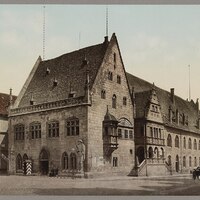Roland in Halberstadt
Type:
Sculptures
Date:
1433
Location or Findspot (Modern-Day Country):
Germany
Medium:
Stone
Dimensions:
H 4.27 m
Description:
Statues that supposedly depict the legendary hero Roland were often erected in German-speaking lands in the fourteenth and fifteenth centuries. These sculptures are notable for their impressive height—from 4 to 10 meters tall—and standardized iconography: they show the hero as an armed knight who often bears the double-eagle emblem of the Holy Roman Empire on his shield. The Roland in Halberstadt was commissioned in wood in 1381 and replaced by a sandstone replica in 1433. Until the Rolands appeared, no colossal freestanding figures had been produced in Europe for a thousand years.
The historical Roland was a Frankish military leader under Charlemagne, briefly mentioned in that ruler's ninth-century biography. He was probably killed by Basques in the Pyrenees Mountains while accompanying Charlemagne's army north from Spain. This minimal information was amplified in medieval literature, especially the Chanson de Roland (Song of Roland). It described Roland as a man of great height and gave him a distinctive sword and horn (an oliphant). He was eventually conceptualized as a noble Christian martyr who defeated pagan and Muslim enemies.
In medieval German cities, the colossal sculptures were perceived as living giants who oversaw the mercantile and civic activities that took place near their installation sites, which were usually along riverbanks or in public squares. Fierce giants appeared in contemporary travel literature, such as the mid-fourteenth-century account of the armchair traveler Sir John Mandeville. The "aliveness" and real presence of the sculpted Rolands would have been more apparent in the original wooden versions, because medieval viewers recognized wood as a living material, but even stone giants held the potential for miraculous urban intervention.
The historical Roland was a Frankish military leader under Charlemagne, briefly mentioned in that ruler's ninth-century biography. He was probably killed by Basques in the Pyrenees Mountains while accompanying Charlemagne's army north from Spain. This minimal information was amplified in medieval literature, especially the Chanson de Roland (Song of Roland). It described Roland as a man of great height and gave him a distinctive sword and horn (an oliphant). He was eventually conceptualized as a noble Christian martyr who defeated pagan and Muslim enemies.
In medieval German cities, the colossal sculptures were perceived as living giants who oversaw the mercantile and civic activities that took place near their installation sites, which were usually along riverbanks or in public squares. Fierce giants appeared in contemporary travel literature, such as the mid-fourteenth-century account of the armchair traveler Sir John Mandeville. The "aliveness" and real presence of the sculpted Rolands would have been more apparent in the original wooden versions, because medieval viewers recognized wood as a living material, but even stone giants held the potential for miraculous urban intervention.
Relevant Textbook Chapter(s):
10
Image Credits:
Wikimedia Commons; Library of Congress



